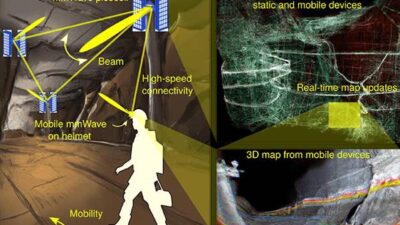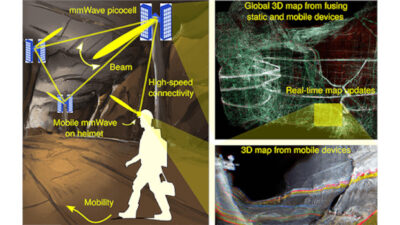Combining 2D and 3D sensing in one package simplifies integration and improves productivity.

One of the biggest challenges for a sawmill stems from the fact that while finished boards are made to standard sizes, trees are not. Optimization is an in-process procedure which maximizes output of highest value board sizes and quality from the limited and environmentally valuable input of random shape logs. In the optimization process, 3D profiles of each raw board are analyzed to position saws optimally to edge the individual boards to width, and trim them to length, removing defective areas and providing the optimized quality and productivity at the end of the line. Optimization can improve yields by an impressive 15% or more. In a larger sawmill cutting an average of 80,000 board feet per shift and running two shifts each day, this can equal a return of $1.35 million per year.
Board optimization traditionally involves mounting 3D laser sensors above and below board conveyor lines to provide high density 3D geometric profiles of each rough board as it passes. Typical inspection rates are up to 120 boards per minute with some systems running as high as 200 boards per minute.
Depending on the length of the boards, 20 or more sensors may be implemented for full surface coverage.
Advances in technology
Over the past three decades, 3D sensing has evolved significantly, with profile resolution improving from 3 in. (76 mm) to 0.3 in. (7.6 mm) spacing, and frame rates have increased to 2 kHz. These improvements detect smaller defects and making much better decisions on cutting paths.
Detecting surface defects, such as knots, splits, and stains on the boards, uses 2D full-color surface inspection. Early in the cutting process, this 2D information is analyzed automatically to cut out surface defect areas. Adding a separate 2D surface color inspection station can be a challenge. Integrating separate 2D and 3D sensors is complicated, involving cabling, tracking work pieces through two inspection areas, and synchronizing data from all sensors. The resulting system has many elements, is expensive, and maintenance intensive.
Simplifying integration
To simplify the challenge in these types of applications, LMI Technologies has introduced a family of sensors which combine 3D high density profile scanning with true-color 2D imaging for automated visual inspection for surface defects into the same sensor package. Built into each sensor are laser projectors for 3D profiling aswell as high power LED’s and imagers for surface imaging. With a frame rate of 2 kHz or higher, these sensors provide very high speed inspection capability. One such sensor is the LMI DynaVision chroma+scan 3300 3D profile and color sensor.
Integrating 2D and 3D inspection capability in one sensor package is the first step in simplifying the integrator’s tasks. Sensors are provided to the integrator with internal processing able to apply the optical calculation equations and factory developed linearization factors, providing automatic gain control to ensure accurate readings independent of the object surface texture and color, while converting measured values to engineering units.
Using multiple sensors to cover large pieces creates challenges of synchronizing data and stitching multi-sensor data streams into one file. To simplify these tasks, LMI developed a synchronization platform known as FireSync, designed to accept and integrate data from multiple vision sensors and otherl inputs, such as encoders and photocells monitoring parts passing on the conveyor.
Combining 3D measurement and 2D color data in the platform also allows for internal parallax correction of the 2D map that can be caused by the work pieces variation in thickness or movement toward the sensors. This ensures that the 3D profile and the 2D color map match exactly no matter how the work piece is positioned (see graphic).
Moving all that data
Even with smart sensors which internally reduce optical information to engineering measurements, today’s sensors can generate hundreds or thousands frames per second, with each frame containing hundreds to thousands of data points. An industrial standard communication protocol simplifies the integrator’s job while reducing cost and risk of implementation.
A user can choose from a number of standards, including USB 2.0, FireWire, and Camera Link, which was developed for industrial and scientific imaging. Each of those has useful features, but more recently gigabit Gigabit Ethernet (GigE) has emerged as a favorite and been broadly accepted. It’s easy to apply with inexpensive cabling running up to 100 m without repeaters. Data is sent from the platform over a single GigE output cable to the host computer, reducing wiring costs and improving reliability.
Easier, multi-function inspection
Sensor arrays outfitted with combined 2D and 3D sensing simplify the task of integrating complex multi-function inspection systems. With internal data processing in the sensor, multiple sensor synchronization and data stitching provided by the FireSync platform, and standard GigE communications, risk and development costs for the integrator are minimized. Combined function sensors minimize complexity, simplify mounting and cabling tasks, and reduce system cost. When the system is installed, the end user benefits from system simplicity, with reduced maintenance costs and ease of operation.
– Dr. Walter Pastorius is technical marketing adviser for LMI Technologies Inc.
https://lmitechnologies.com
See other machine vision tutorials and feature articles in the June/July 2010 issue of Control Engineering, Machine Vision / Inside Machines section, and:
– Help for tire and rubber manufacturing: Inspection system improves quality
– Sensors for High-Speed Applications
– Sensors for better cow milking: LMI Technologies secures patent



